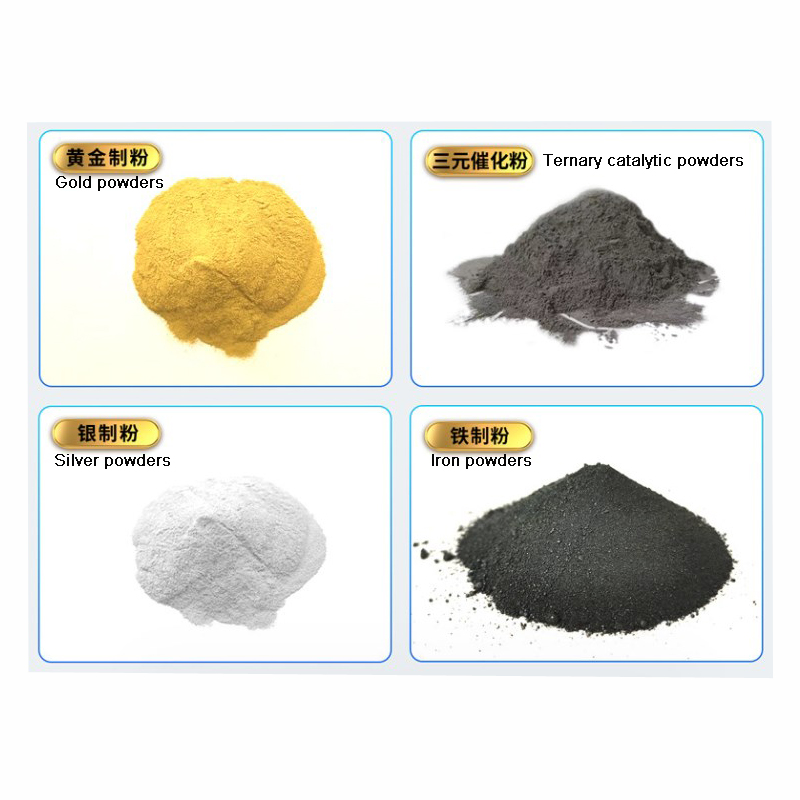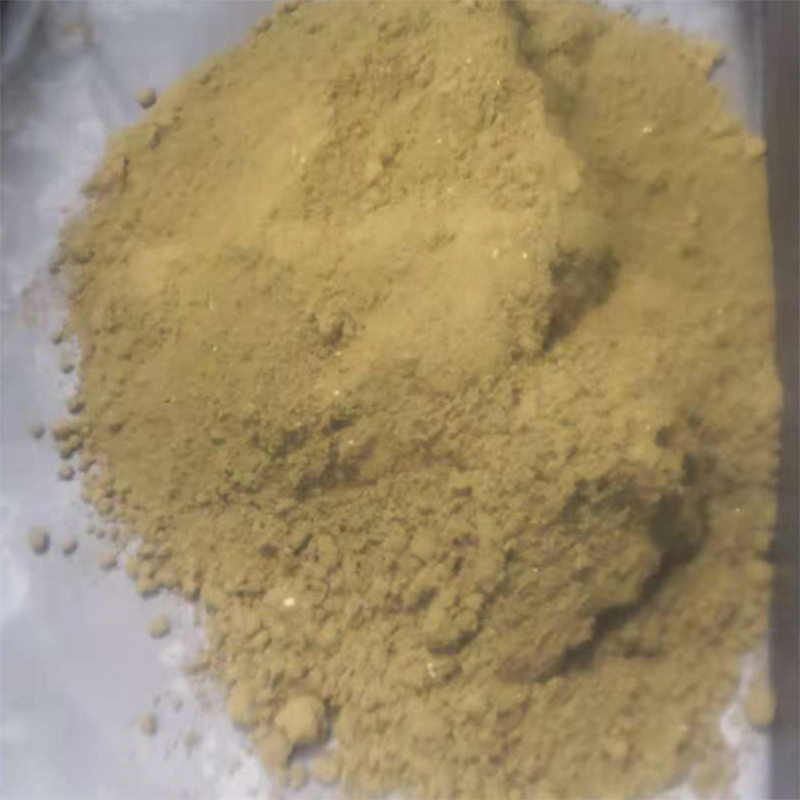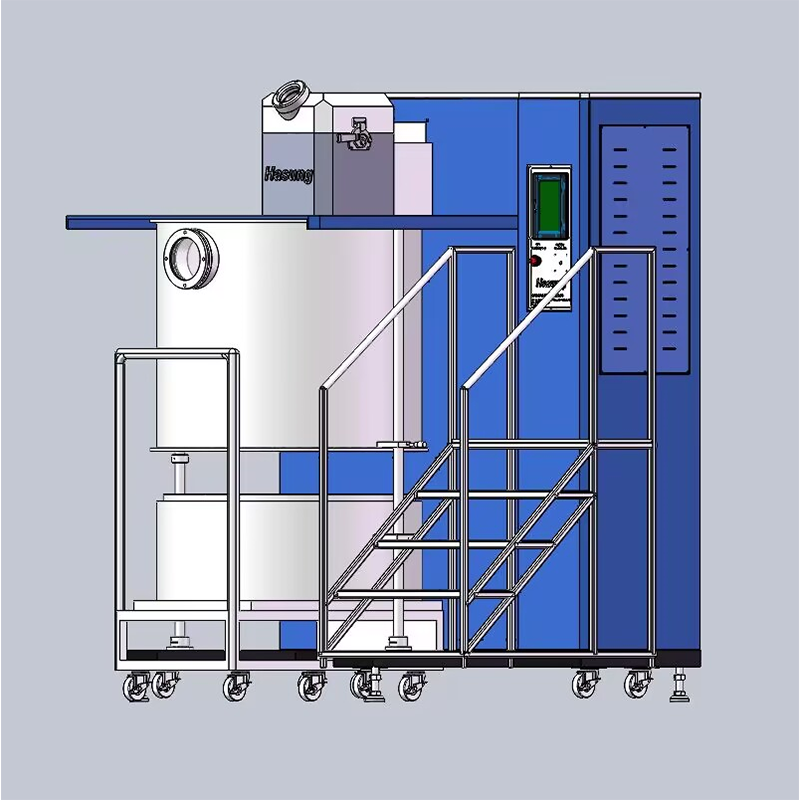
Metal Powder Water Atomizer For Precious Metal Platinum Palladium Steel
Technical Parameter
| Model No. | HS-MI4 | HS-MI10 | HS-MI20 |
| Voltage | 380V 3 Phases, 50/60Hz | ||
| Power Supply | 15KW | 25KW | 40KW |
| Max Temp. | 2100°C | ||
| Melting Time | 3-5 Min. | 5-8 Min. | 5-8 Min. |
| Casting Grains | 80#-200#-400#-500# | ||
| Temp Accuracy | ±1°C | ||
| Capacity (Pt) | 4kg | 10kg | 30kg |
| Vacuum Pump | (optional) | ||
| Application | Gold, silver, copper, alloys; Platinum(Optional) | ||
| Operation method | One-key operation to complete the entire process, POKA YOKE foolproof system | ||
| Control System | Taiwan Weinview + Siemens PLC intelligent control system | ||
| Shielding Gas | Nitrogen/Argon | ||
| Cooling type | Water chiller (Sold separately) | ||
| Dimensions | 1180x1070x1925mm | 1180x1070x1925mm | 3575*3500*4160mm |
| Weight | approx. 460kg | approx. 560kg | approx. 2150kg |
| High Pressure Water pump | included | ||
Features
HS-MI1 is a family of water atomizers designed to produce metal powders of irregular shape, to be used in industrial, chemical, soldering paste, resin filters, MIM and sintering applications.
The atomizer is based on an induction furnace, working in a closed chamber under protective atmosphere, where the molten metal is poured and hit by a jet of high pressure water, producing fine and deoxidized powders.
Induction heating ensures a very good homogenization of the melt thanks to the action of magnetic stirring during the molten phase.
The die unit is equipped with an extra induction generator, which allows to restart the cycle in case of cycle interruption.
Following the steps of melting and homogenization, the metal is poured vertically through an injection system positioned on the lower base of the crucible (nozzle).
Multiple streams of high pressure water are aimed and focused on the metal beam in order to ensure a fast alloy solidification in the form of fine powder.
Real-time process variables such as temperature, gas pressure, induction power, oxygen ppm content in the chamber and many others, are displayed in both numerical and graphical format on a monitoring system for an intuitive understanding of the working cycle.
The system can be operated manually or in fully automatic mode, thanks to the programmability of the entire set of the process parameters via a user-friendly touch-screen interface.
Process Of Making Metal Powder By Water Atomization Pulverizing Equipment
The process of making metal powder by water atomization pulverizing equipment has a long history. In ancient times, people poured molten iron into water to make it burst into fine metal particles, which were used as raw materials for making steel; until now, there are still people who pour molten lead directly into water to make lead pellets. . Using the water atomization method to make coarse alloy powder, the process principle is the same as the above-mentioned water bursting metal liquid, but the pulverization efficiency has been greatly improved.
The water atomization pulverizing equipment makes coarse alloy powder. First, the coarse gold is melted in the furnace. The melted gold liquid must be overheated by about 50 degrees, and then poured into the tundish. Start the high-pressure water pump before the gold liquid is injected, and let the high-pressure water atomization device start the workpiece. The gold liquid in the tundish passes through the beam and enters the atomizer through the leaking nozzle at the bottom of the tundish. Atomizer is the key equipment for making coarse gold alloy powder by high-pressure water mist. The quality of the atomizer is related to the crushing efficiency of metal powder. Under the action of high-pressure water from the atomizer, the gold liquid is continuously broken into fine droplets, which fall into the cooling liquid in the device, and the liquid quickly solidifies into alloy powder. In the traditional process of making metal powder by high-pressure water atomization, the metal powder can be collected continuously, but there is a situation that a small amount of metal powder is lost with the atomizing water. In the process of making alloy powder by high-pressure water atomization, the atomized product is concentrated in the atomization device, after precipitation, filtration, (if necessary, it can be dried, usually directly sent to the next process.), to obtain fine Alloy powder, there is no loss of alloy powder in the whole process.
A complete set of water atomization pulverizing equipment The equipment for making alloy powder consists of the following parts:
Smelting part: an intermediate frequency metal smelting furnace or a high-frequency metal smelting furnace can be selected. The capacity of the furnace is determined according to the processing volume of metal powder, and a 50 kg furnace or a 20 kg furnace can be selected.
Atomization part: The equipment in this part is non-standard equipment, which should be designed and arranged according to the site conditions of the manufacturer. There are mainly tundishes: when the tundish is produced in winter, it needs to be preheated; Atomizer: The atomizer will come from high pressure The high-pressure water of the pump impacts the gold liquid from the tundish at a predetermined speed and angle, breaking it into metal droplets. Under the same water pump pressure, the amount of fine metal powder after atomization is related to the atomization efficiency of the atomizer; the atomization cylinder: it is the place where the alloy powder is atomized, crushed, cooled and collected. In order to prevent the ultra-fine alloy powder in the obtained alloy powder from being lost with water, it should be left for a period of time after atomization, and then placed in the powder collecting box.
Post-processing part: powder collecting box: used to collect the atomized alloy powder and separate and remove excess water; drying furnace: dry the wet alloy powder with water; screening machine: sieve the alloy powder, Out-of-specification coarser alloy powders can be re-melted and atomized as return material.
The Development Trend Of Atomization Pulverizing Equipment In The Future
There are still many deficiencies in the understanding of 3D printing technology in all aspects of China's manufacturing industry. Judging from the actual development situation, so far 3D printing has not achieved mature industrialization, from equipment to products to services still in the "advanced toy" stage. However, from the government to enterprises in China, the development prospects of 3D printing technology are generally recognized, and the government and society generally pay attention to the impact of the future 3D printing metal atomization pulverizing equipment technology on my country's existing production, economy, and manufacturing models.
According to the survey data, at present, my country's demand for 3D printing technology is not concentrated on equipment, but is reflected in the variety of 3D printing consumables and the demand for agency processing services. Industrial customers are the main force in purchasing 3D printing equipment in my country. The equipment they purchase is mainly used in aviation, aerospace, electronic products, transportation, design, cultural creativity and other industries. At present, the installed capacity of 3D printers in Chinese enterprises is about 500, and the annual growth rate is about 60%. Even so, the current market size is only about 100 million yuan per year. The potential demand for R&D and production of 3D printing materials has reached nearly 1 billion yuan per year. With the popularization and progress of equipment technology, the scale will grow rapidly. At the same time, 3D printing-related entrusted processing services are very popular, and many agents 3D printing The equipment company is very mature in the laser sintering process and equipment application, and can provide external processing services. Since the price of a single equipment is generally more than 5 million yuan, the market acceptance is not high, but the agency processing service is very popular.
Most of the materials used in my country's 3D printing metal atomization pulverizing equipment are directly provided by rapid prototyping manufacturers, and the third-party supply of general materials has not yet been implemented, resulting in very high material costs. At the same time, there is no research on powder preparation dedicated to 3D printing in China, and there are strict requirements on particle size distribution and oxygen content. Some units use conventional spray powder instead, which has many inapplicability.
The development and production of more versatile materials is the key to technological advancement. Solving the performance and cost problems of materials will better promote the development of rapid prototyping technology in China. At present, most of the materials used in my country's 3D printing rapid prototyping technology need to be imported from abroad, or the equipment manufacturers have invested a lot of energy and funds to develop them, which are expensive, resulting in increased production costs, while the domestic materials used in this machine have low strength and precision. . The localization of 3D printing materials is imperative.
Titanium and titanium alloy powders or nickel-based and cobalt-based superalloy powders with low oxygen content, fine particle size and high sphericity are required. The powder particle size is mainly -500 mesh, the oxygen content should be lower than 0.1%, and the particle size is uniform At present, high-end alloy powder and manufacturing equipment still mainly rely on imports. In foreign countries, raw materials and equipment are often bundled and sold to earn a lot of profits. Taking nickel-based powder as an example, the cost of raw materials is about 200 yuan/kg, the price of domestic products is generally 300-400 yuan/kg, and the price of imported powder is often more than 800 yuan/kg.
For example, the influence and adaptability of powder composition, inclusions and physical properties on the related technologies of 3D printing metal atomization powder milling equipment. Therefore, in view of the use requirements of low oxygen content and fine particle size powder, it is still necessary to carry out research work such as composition design of titanium and titanium alloy powder, gas atomization powder milling technology of fine particle size powder, and the influence of powder characteristics on product performance. Due to the limitation of milling technology in China, it is difficult to prepare fine-grained powder at present, the powder yield is low, and the content of oxygen and other impurities is high. During the use process, the powder melting state is prone to unevenness, resulting in high content of oxide inclusions and denser products in the product. The main problems of domestic alloy powders are in product quality and batch stability, including: ① stability of powder components (number of inclusions, uniformity of components); ② powder physical Stability of performance (particle size distribution, powder morphology, fluidity, loose ratio, etc.); ③ problem of yield (low yield of powder in narrow particle size section), etc.
Product Display


- English
- French
- German
- Portuguese
- Spanish
- Russian
- Japanese
- Korean
- Arabic
- Irish
- Greek
- Turkish
- Italian
- Danish
- Romanian
- Indonesian
- Czech
- Afrikaans
- Swedish
- Polish
- Basque
- Catalan
- Esperanto
- Hindi
- Lao
- Albanian
- Amharic
- Armenian
- Azerbaijani
- Belarusian
- Bengali
- Bosnian
- Bulgarian
- Cebuano
- Chichewa
- Corsican
- Croatian
- Dutch
- Estonian
- Filipino
- Finnish
- Frisian
- Galician
- Georgian
- Gujarati
- Haitian
- Hausa
- Hawaiian
- Hebrew
- Hmong
- Hungarian
- Icelandic
- Igbo
- Javanese
- Kannada
- Kazakh
- Khmer
- Kurdish
- Kyrgyz
- Latin
- Latvian
- Lithuanian
- Luxembou..
- Macedonian
- Malagasy
- Malay
- Malayalam
- Maltese
- Maori
- Marathi
- Mongolian
- Burmese
- Nepali
- Norwegian
- Pashto
- Persian
- Punjabi
- Serbian
- Sesotho
- Sinhala
- Slovak
- Slovenian
- Somali
- Samoan
- Scots Gaelic
- Shona
- Sindhi
- Sundanese
- Swahili
- Tajik
- Tamil
- Telugu
- Thai
- Ukrainian
- Urdu
- Uzbek
- Vietnamese
- Welsh
- Xhosa
- Yiddish
- Yoruba
- Zulu
- Kinyarwanda
- Tatar
- Oriya
- Turkmen
- Uyghur























